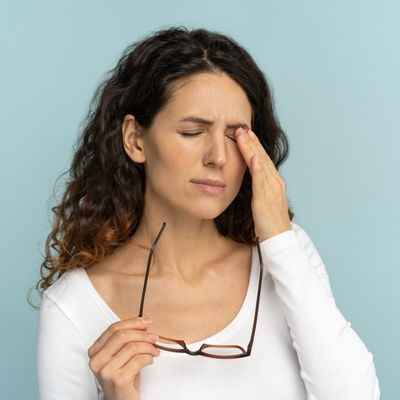Many people need glasses to live their life to the fullest and perform daily activities. Unfortunately, sometimes a new pair of lenses can have the wrong prescription in them. This can happen for a number of reasons, but what’s important is to recognize the signs that you’re wearing the wrong glasses prescription so that you have them corrected as soon as possible.
5 signs that you’re wearing the wrong glasses prescription include:
- Blurry vision
- Headaches
- Squinting
- Sensitivity to light
- Vertigo
Signs That You’re Wearing the Wrong Glasses Prescription
1. Blurry Vision
Blurry vision is one of the most common symptoms of having the wrong eyewear prescription and should be addressed immediately. You can experience blurry vision from your prescription glasses even if they’re off by a few degrees. This can occur either due to having the wrong prescription or because you received the wrong prescription by accident.
Alternatively, sudden blurry vision may indicate a change in your vision. In this case, you’ll still need to update your prescription to see comfortably.
There is an easy test to see if you have the correct prescription or not. You can do this by:
- Putting your new glasses on
- Cover one eye
- Look straight ahead with your other eye
- Note whether your vision looks blurred or hazy
- Repeat with the other eye
Is one eye blurry or hazy while the other is clear? If so, this is a sure sign that you don’t have the right prescription for your vision.
Contact our office immediately if you experience blurry vision for longer than the usual adjustment period (about two weeks). Dr. Travis Thompson or Dr. Catherine Abbott can reevaluate your prescription and provide you with the correct one so you can see clearly and comfortably.
Click here to learn the signs that you need to update your eyewear prescription!
2. Headaches
Headaches are another common symptom of wearing the wrong eyewear prescription. This is caused by eyestrain which results from your eyes being overworked. It’s a common occurrence when you have been staring at your computer screen or digital devices for too long or have been driving long distances.
Eyestrain manifests as pain behind or around your eyes. It is often described as an aching, dull throb at the front of your head. You can test to see if your glasses are the cause of your headaches by taking them off at certain times of the day to see if their severity or frequency lessens or not. If they do, then there’s a good chance your glasses are the culprit.
One specific form of eyestrain is digital eye strain, also known as computer vision syndrome. It’s caused by looking at digital screens for too long and can occur even when you’re wearing the right prescription. Many patients have had great results with blue light glasses (computer glasses). However, another great strategy is to follow the 20-20-20 rule.
To follow the 20-20-20 rule, simply:
- Look at an object 20 feet away
- Every 20 minutes
- For 20 seconds
This will help relieve your digital eye strain symptoms and have you seeing and working comfortably all day.
To learn more about digital eye strain and how to avoid it, click here!
3. Squinting
Squinting is the natural response when your vision isn’t as clear or focused as it should be. While your new glasses should prevent squinting and help you see more clearly, a wrong or out-of-date prescription can actually make the problem worse. This can be confusing if you don’t recognize the problem quickly and cause you to live in discomfort for longer than necessary.
Squinting can actually cause more problems if you don’t update your prescription as soon as possible. As with headaches, squinting can lead to eye strain which puts an unnecessary amount of stress on your eyes. This can actually make your vision problems worse, especially when reading or working while using digital screens for longer periods of time.
4. Sensitivity to Light
Like squinting, sensitivity to light can be an indicator that your eyes are working harder than they normally do. It’s natural to squint when you’re out in the sun, but squinting while indoors due to light definitely points to a more serious problem. This is especially true if your light sensitivity is accompanied by pain. In this case, a visit to the eye doctor is in order to determine the problem.
Sensitivity to light doesn’t always mean that there’s a problem with your prescription. It’s a common symptom of a lot of eye problems, including:
- Dry eye
- An infection
- Swelling
- An eye injury
- Eye diseases
Contact us immediately if you experience recurring light sensitivity or if it gets worse over time. Our team can determine if it’s being caused by an incorrect glasses prescription, or if there’s another problem, and provide treatment.
5. Vertigo
Unlike dizziness which can be cured by sitting or lying down, vertigo is a much more serious problem. For one thing, it lasts much longer than a bout of dizziness. For another, it will continue even when you manage to sit or lay down. Vertigo is often associated with inner ear problems but it can also develop or even worsen if you’re wearing the wrong glasses prescription.
Vertigo caused by an incorrect lens prescription may be due to changes in depth perception. This can occur when using a new type of lens such as reading glasses or bifocals. If you already have vertigo then these new lenses can make the problem much more severe. However, it may also point to a more serious health problem that requires immediate treatment.
Are you having trouble with your glasses and think it may be due to an incorrect prescription? Contact us today to schedule your appointment!
Blurry vision is one of the primary signs of an incorrect eyeglasses prescription. Headaches can occur due to eyestrain from compensating for the wrong prescription. Similarly, eye strain can cause you to squint to focus your vision and see more clearly. Squinting indoors can also indicate light sensitivity due to the incorrect prescription. In some cases, the wrong prescription can cause or worsen cases of vertigo making it difficult to move around while wearing glasses.
Hardin Valley Eyecare & Optical has been serving Knoxville since 2009. Dr. Travis Thompson and Dr. Catherine Abbott specialize in the diagnosis and treatment of a wide array of eye diseases, conditions, and problems and are committed to improving the quality of life in the Knoxville community through enhanced vision. Located at 10904 Spring Bluff Way, you can schedule an appointment online or give us a call at (865) 888-0892.





